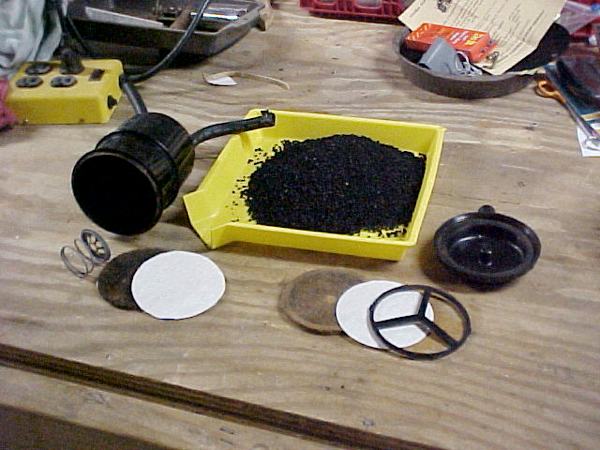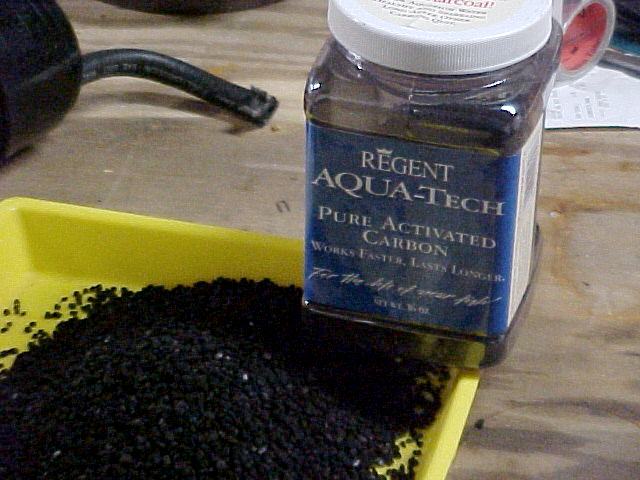At the recent carburetor tech session at Brookland's by Matt Graham, Matt suggested that leaving the charcoal canisters (Evaporative Emission Control System) in the car is not a bad thing, as they don't take away from the engine's horsepower, and do help with venting and environmental concerns. Keeping this in mind, I obtained permission from Gerry Masterson to reprint the following article that he wrote once upon a time about replacing the charcoal found in the canisters. - Tony
Our MGB's use a charcoal canister to trap gas fumes from the gas tank and the carburetor float bowls. The trapped fumes are then sucked through the valve cover, through the crankcase and out the vent on the tappet cover on the side of the engine by carb vacuum. This system uses absolutely no energy to operate so it should be left functional when you remove the air pump and other emission equipment. Over time, the filters and charcoal degrades to the point of being sucked into the crankcase. One thing you do not want in your crankcase is bits of charcoal.
Repairing the charcoal canister is not all that hard. The first thing you have to do is to open it up and clean out all the old contents. The bottom unscrews to expose the retainer. The retainer is the piece that looks like a ring divided into thirds.

Disassembly of MGB charcoal canister
Notice the ring has six tabs in it that fit in matching slots in the bottom of the canister.
These have to be carefully depressed so the retainer will be released. After the retainer is removed, you will find a filter made of plastic gauze. Pull this out and examine it. If it is in decent condition set it aside for reuse.
Under it you will find the old charcoal. It looks like black pellets. Dump these in the trash. They are not re-useable. Under the charcoal you will find another filter like the first one and a steel mesh screen. If the screen is intact, save it for reuse or replace it.
Next you will find a special washer and a spring. These should be cleaned up for reuse also.
Okay, now you have it all out and in front of you. If the two filters are not re-useable, you can make replacements from filter paper. I had access to some filter paper so I cut several 3-1/2" circles. Lacking this, you can use plain old coffee filters. Look around for some large enough to cut the discs from without leaving any holes. After you make your new filters, you are ready to go back together with everything.

Replacement charcoal for MGB Evaporative Emission Control System
For charcoal, I used plain old aquarium filter charcoal that's available from any store that sells aquarium supplies. You'll need about 8-ounces of charcoal. You can wash it first, and dry it in your kitchen oven.
When you are ready to reassemble your canister, start by placing the spring and special washer in place in the bottom of the canister. Next, install the steel mesh with either your old filter or your new, homemade filter on top. My original filter was re-useable so I used both the old and the new one.
Next comes the charcoal. Put about 8-ounces in. It should fill the canister up to the point where the other filter and retaining ring will just fit in place. It you overfill by a bit, it will not matter, as the spring will compress enough to keep pressure on everything. You want the whole packed bed of charcoal held in place by the spring.
On top of the charcoal goes your second filter and then the retainer. Be sure the retainer locks in place with its six tabs in their matching slots. Now all that is left is to screw the bottom back in place, reinstall the canister back in your car, and hook the hoses back up. Not so hard after all, was it?
This article was originally posted on Tony Barnhill's website "The Autoist"
How to cleanse and refresh the charcoal canister, a video by John Twist of University Motors
















My question has to do with the vapor seperator. What's the principle of operation of this device? And the long section of bent tubing that goes from the vented gas tank to the vapor seperator?
Thanks,
John Saggese
419-346-5920
john@saggese.net
I'll admit Im not an expert in this kind of system, but it seems unnecessarily complex. Why not just vent the fuel tank through a charcoal cannister and discharge the ejected air (minus the gasoline vapors) directly under the car (away from the muffler)?
I'd appreciate your comments.
John Saggese
419-346-5920
john@saggese.net
FRM
saturated, but I'm not sure how long that would take. Do you know how
to tell when activated charcoal is saturated?
John Saggese
Re vapour separator: It is just what it sounds and looks like, a tin can to catch any liquid that gets up the vent line from the tank, on 4G turns etc. Then the liquid drains out the bottom back to the tank, and the vapour goes out the top to the canister. The original line from tank to separator is a Petroflex hose, with no low points, and the top connection is variable to a steel pipe running forward. And, the tank is NOT vented, as this IS the vent = the whole point of the system.
FRM
Stan
Want to leave a comment or ask the owner a question?
Sign in or register a new account — it's free